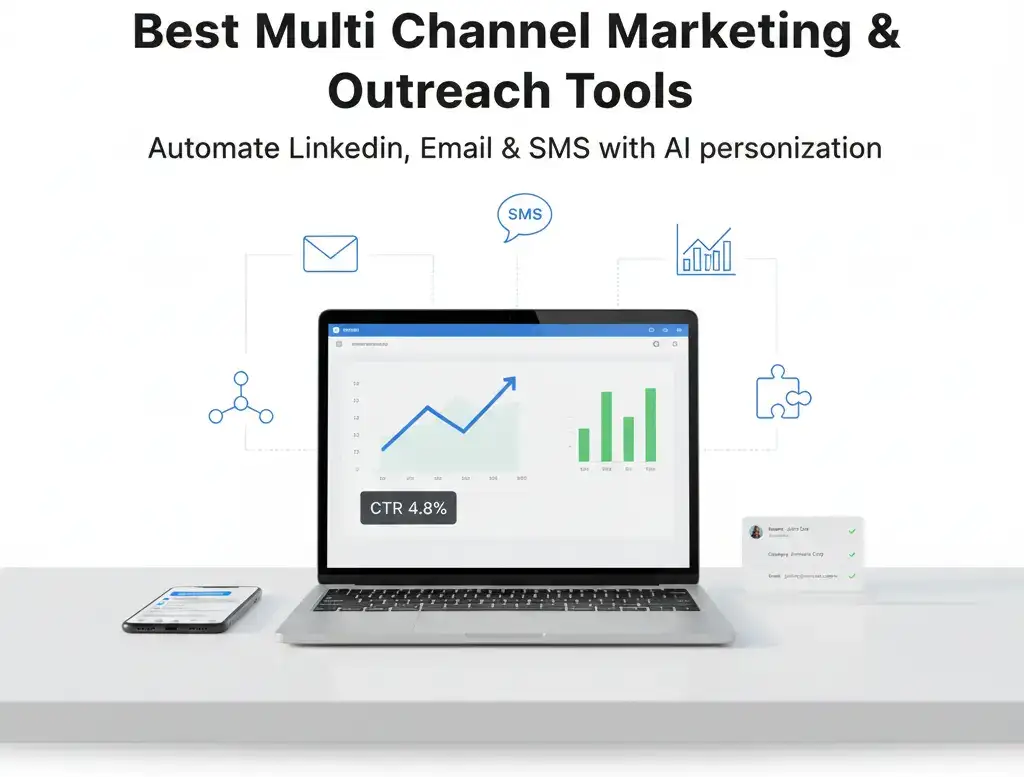We test and review software products using an independent, multipoint methodology. If you purchase something through our links, we may earn a commission. Read about our editorial process.
In 2025, people expect a simple and clear approach: one system that includes email, LinkedIn and SMS, a clear dashboard, fast tracking and transparent reporting. That is why multi channel marketing software is important not as a trendy name, but as the basis of daily work.
It pulls data through integration with CRM, helps to segment by behavior, shows performance and provides insights that are easily converted into actions: who to write to, when to remind, which channel to strengthen for better conversion and retention. The recipe is simple: less manual routine, more automation, stable workflow and neat communication with the audience without intrusiveness.
When you launch your first campaign, don’t chase a hundred features. You need basic things that really give movement: fast import of contacts, clear targeting, convenient email editor, cleanliness of the database, flexible scheduling, and analytics that can be seen without a magnifying glass.

Good channel marketing software should tell you how to optimize your frequency, when to test your email subject line, and when to pause on LinkedIn. If the tool immediately shows you how your audience is responding and where engagement is being lost, you save days, not minutes.
Multi-channel outreach is not about “bombing everywhere,” but about polite consistency. First, useful content, then a short, human email, then a light touch on LinkedIn, and if necessary, a concise SMS. Automation keeps the rhythm going, but leaves room for a personal response.
It’s important to maintain a single branding line: one idea, different formats, no dissonance. This is how engagement grows, and conversion looks like a logical step, not a fluke.
Strong cross channel marketing platforms pull all sources into one window, build a contact profile, and suggest which channel will work best and when. Not only general analytics are valuable here, but also small insights: how the audience behaves after the second email, what changes when you move the message from morning to evening, whether personalization in the subject and first line helps.
Such a platform does not live by “decoration”, but by specific solutions: reconfigure scheduling, change segments, enable a new trigger in multichannel marketing automation.
Automation is stop lights and smart rhythms. Triggers for behavior (opened, clicked, left the form), frequency limits, sending windows, unsubscribe control, domain warming up - such little things save your reputation from unnecessary risk.
When multi channel marketing tools also show where exactly the chain is sagging, you quickly optimize: remove unnecessary things, add an example, change the call-to-action, shuffle the order of channels. As a result, we have cleaner communication, better delivery, stable conversion and a healthy base for the next waves.
The difference is simple: multi channel software is a daily “desktop” for launching and running campaigns, and multi channel marketing platform is a broader ecosystem with deep integration, reporting, and access rules. If the team is small, start with software and enable modules gradually.

If there are many channels and teams, a platform with management levels and full reporting will save you nerves. In any case, make sure that everything is easily friendly with CRM and that the workflow does not break down over trifles.
Ready-made multi channel marketing solutions are packages for tasks: lead generation, warm-up, upsell, reactivation. They speed up the start, but do not cancel common sense: adapt to your audience, NPS, and sales cycle.
And channel marketing programs maintain team discipline: tone rules, templates, a library of responses, a transparent review of letters and posts. The program removes chaos, makes learning fast and supports a single brand line without micro-management.
To avoid getting distracted, keep a basic list that covers 80% of tasks and scales well:
Email editor with deliverability, A/B testing and simple reporting
LinkedIn module for sequences that take into account previous actions
SMS gateway with frequency and time windows
Analytics with live-tracking, segmentation and a convenient dashboard
Native integration with CRM and painless import/export
Rights management, change history and activity log
Start with a simple model: one audience - one message - three touches across channels. Then turn on reporting and look at key metrics: letter openings, responses, conversions, demos, deals. Don’t chase the “perfect” number right away: stable performance is built through iterations.
If you see a drop after the second step - change the order of channels or simplify the copywriting. If the noise is growing - reduce the frequency and narrow the targeting. Your rule: small changes every week are better than a “big overhaul” once a quarter.
The bottom line is simple: take tools that do not overload, set up a minimal but reliable framework (segmentation, personalization, scheduling, reporting), keep the pace and respect people. So multichannel outreach doesn't look like spam, but like a useful conversation, where every step is logical and every channel works "in unison."
An approach in which we work across multiple channels simultaneously (email, LinkedIn, SMS, etc.), with a single idea and an agreed schedule, to increase engagement and drive conversion without unnecessary pressure.
Omnichannel - a seamless experience between points with a single profile and context; multichannel - working in different channels with simpler communication. Both approaches can give results, but multichannel is easier, faster and cheaper to start.
A useful post or guidance, then a short email with a proposal, then contact on LinkedIn and, if necessary, a reminder via SMS with a clear next step. One message - different formats, agreed pace.
Depends on the country, niche and experience. Where automation, analytics and processes are well-configured, the payment is usually above average, because the specialist affects revenue consistently, not one-time.